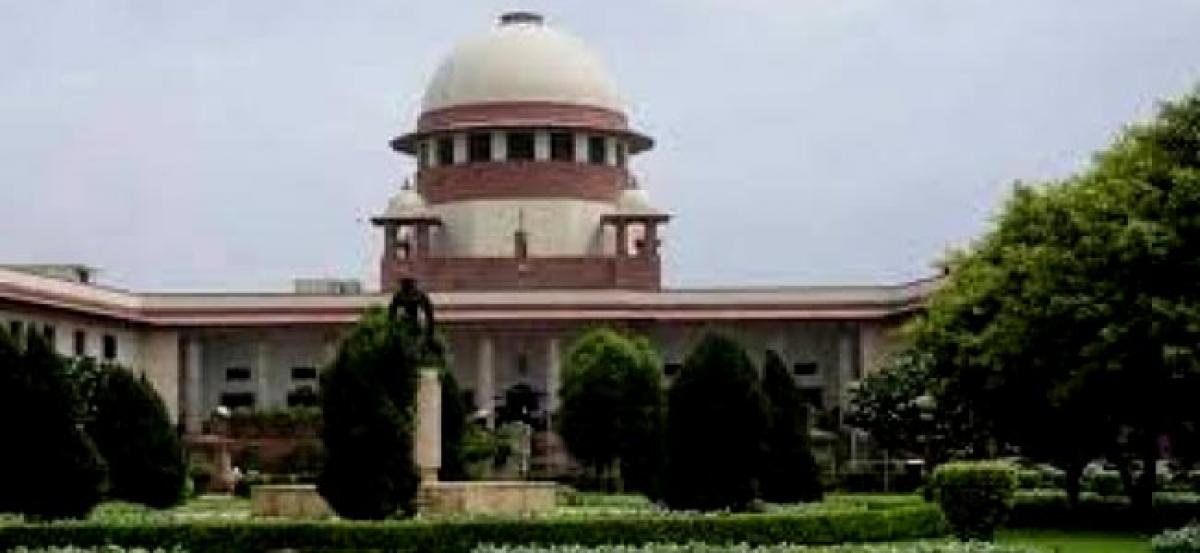Live
- KJo on 23 years of ‘Kabhi Khushi Kabhie Gham’: One of those pinch me moments
- WPL 2025 auction: Nandini, Kamalini set to be most sought-after names
- MP CM to inaugurate Sarsi resort in Shahdol, 200-bed hospital in Mauganj today
- TGPSC makes arrangements for Group-2 exams to be held tomorrow
- WPL 2025 Auction: When and where to watch, date, time, live streaming, venue
- Japan: Citizens protest US military-related sexual violence
- Buy on dips strategy working well in Indian stock market amid sharp rebound
- Sri Lanka concludes sovereign bond restructuring
- Lal Krishna Advani hospitalised at Delhi's Apollo Hospital
- Modi performs puja at Triveni
Just In

The Supreme Court today said the Memorandum of Procedure (MoP) for appointments to the higher judiciary has been cleared and the process of filling the vacancies in the high courts was proceeding on a \"war footing\".
The Supreme Court today said the Memorandum of Procedure (MoP) for appointments to the higher judiciary has been cleared and the process of filling the vacancies in the high courts was proceeding on a "war footing".
A bench headed by Chief Justice JS Khehar, while disposing of PILs seeking filling of vacancies for reducing the huge pendency of cases, said progress has been made and the number of posts of judges in high courts would be increased by 25 per cent. "In the first stage, we will look into the filling up of vacancies of high court judges and then we will look into increasing the number of high court judges," the bench, also comprising Justices DY Chandrachud, said.
The bench said a committee of senior apex court judges has been formed for suggesting ways for reducing the pendency of cases up to three years. It also gave liberty to Delhi BJP spokesperson and advocate Ashwini Upadhaya to approach the apex court if he wanted to suggest ways to increase the number of judges. The bench also disposed of other petitions pertaining to the same issue.
Earlier, this month the Supreme Court collegium finalised the MoP for appointment of judges in the higher judiciary, ending a year-long face-off with the executive by agreeing to include the contentious clause of national security in selection of judges. It had agreed to the national security clause, which the government had been insisting be included as one of the necessary criteria for appointment of judges to the higher judiciary.
The collegium after deliberations had also agreed on setting up secretariats in the apex court and the high courts to collate data about judges and assist in the selection procedure for their appointment to the higher judiciary. Earlier, on January 2, the Supreme Court had questioned the Centre as why judges and chief justices of high courts are not being transferred despite the recommendations of the collegium and asked it to file a status report on such pending transfers with detailed reasons in two weeks.
The apex court had said continuance of such judges in the same high court gave rise to "speculation and misgivings". It had asked the Centre to return the recommendations to the collegium for reconsideration instead of "sitting over" those. The apex court had on November 18, last year said it had not accepted the Centre's stand of rejecting the 43 names recommended by the Supreme Court Collegium for appointment as judges of the various high courts and most of the names have been sent back for reconsideration.
The Centre had told the court that it has cleared 34 names out of the 77 recommended by the collegium. The court had at an earlier hearing said it would not tolerate "logjam in judges' appointment" and intervene to "fasten accountability as the justice delivery system is collapsing". The bench had said that if the government had reservation about any name, it could always come back to the collegium.

© 2024 Hyderabad Media House Limited/The Hans India. All rights reserved. Powered by hocalwire.com







